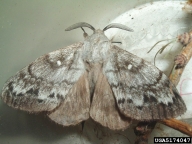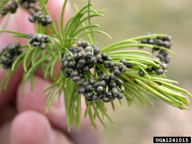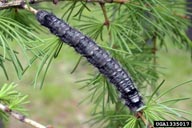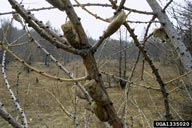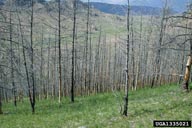Siberian moth
Dendrolimus sibiricus TschetvericKov (Lepidoptera: Lasiocampidae)
Orientation to pest
Siberian moth, Dendrolimus sibiricus TschetveriKov, is a defoliator of great importance in northern Asia, causing widespread, extensive mortality to various conifers during outbreaks. It does not occur in North American but is a species of great concern. Typically, this moth has a two-year life cycle, spread over parts of three calendar years. Adults fly and lay eggs from late June to mid-July. Eggs are laid in chains or clusters on needles or branches. In their first year, larvae feed until they reach the second or third instar and then overwinter in the forest litter. In year two, partly grown larvae continue to feed, at a slower rate, until they are in the fifth to seventh instar, at which stage they overwinter. In their third calendar year, larva feed until mature in spring and pupate inside cocoons fixed to trees. Adult moths appear in late June and July and may fly several kilometers before laying her eggs. Outbreaks occur at about 10 year intervals and last 2-3 years. An outbreak can defoliate thousands of hectares and affect entire forests. Since the insect has overlapping generations and life cycles extending more than one growing season, it can defoliate stands in the spring, summer and fall, but most defoliation occurs in spring when older larvae feed.
Hosts commonly attacked
Larvae of D. sibiricus feed on the foliage of more than 20 species of conifers in northern Asia, especially on species of larch (Larix ) and fir (Abies), but also on less favored hosts such as five-needle and two-needle pines (Pinus) and spruce (Picea). Injury is greatest to species of fir and certain pines (e.g., Pinus koraiensis Sieb. et Zucc. and Pinus sibirica Du Tour). Although larch species are the most favored hosts, they can re-foliate and are seldom killed. It has been shown that this polyphagous species can develop on a wide range of European and North American conifers.
Distribution
The Siberian moth does not occur in North America, but is considered a very high risk invader because of its potential for invasion and the magnitude of likely damage. Boreal and subalpine forests in North America would be at risk. Its current distribution includes Siberia (Russia), northeastern China, northern Mongolia, and part of North Korea.
Images of Siberian moth
| Figure 1. Male Siberian moth, Dendrolimus sibericus | Figure 2. Egg mass of Siberian moth | Figure 3. Larva of Siberian moth |
| Figure 4. Pupal cocoons of Siberian moth | Figure 5. Stand of Siberian larch (Larix sibirica Ledeb.) defoliated by Siberian moth |
Important biological control agents related to this pest species
More than 40 species of parasitoids are known to attack D. sibiricus, of which the most important are the egg parasites Telenomus tetratomus (Thomson) (Scelionidae) and Ooencyrtus pinicola Matsumura (Encyrtidae), the larval parasite Rogas dendrolimi Matsumura (Braconidae), and the larval-pupal parasites Blepharipa schineri (Mesnil.), Blepharipa pratensis Meigen and Lespesia frenchii (Williston) (all Tachinidae).
Web links for information on Siberian moth
- Profile of Dendrolimus sibiricus | United Nations, Food and Agriculture Organization
PDF from the global review of forest pests and disease - Quarantined Pest Data Sheet | EPPO
Dendrolimus sibiricus and Dendrolimus superan - Fact Sheet from Global Invasive Species Database | Invasive Species Specialist Group
- CAPS PRA | USDA APHIS
A mini risk assessment of Siberian silk moth from a N. American perspective - Data Sheet | EXFOR Database, USDA Forest Service
Articles
- Kirichenko, N. I., J. Flament, Y. N. Baranchikov, and J.-C. Grégoire. 2008. Native and exotic coniferous species in Europe - possible host plants for the potentially invasive Siberian moth, Dendrolimus sibiricus Tschtv. (Lepidoptera, Lasiocampidae). OEPP/EPPO Bulletin 38: 259-263.
- Kirichenko, N. I., Y. N. Baranchikov, and S. Vidal. 2009. Performance of the potentially invasive Siberian moth Dendrolimus superans sibiricus on coniferous species in Europe. Agricultural and Forest Entomology 11: 247-254.
